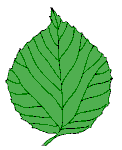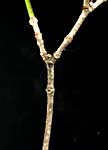|
Viburnum leaf
beetle home
Guide to identifying Viburnums
Common
names
Is
it a viburnum?
Which viburnum?
Express key
ID
tutorial
Guide to viburnums by David Swaciak.
Leaf drawings by
Marcia Eames-Sheavly.
Logo
images by Paul Weston & Craig Cramer
|
|
Leaves:
- Deciduous
- 3 to 5 inches long, 1.25 to
2.5 inches wide
- Rounded with teeth widely
spaced
- Long hairs and brown spots on underside
|

Click for larger image.
|
Flowers:
- Small, creamy-white in flattened clusters 3 to
5 inches in diameter
- Blooms May to early June
|
|
Fruit:
- Bright red,
borne in flattened clusters
- Fruit colors in September and October and
persists into December
|
|
Twigs:
- Stems brown to
gray, glabrous (smooth, right))
|

Click for larger image.
|
|
More information:
Similar
Species and distinguishing characteristics:
Viburnum
dentatum
Leaves 2 to 4 inches long, 1 to 4 inches wide.
Blue-black berries.
|
|
Viburnum
dilatatum
Leaves 2 to 5 inches long, 1 to 3.5 inches wide.
Twigs pubescent (hairy) and with prominent orange lenticels (raised pores).
|
|
Back to beginning Which viburnum is it?
© Copyright, Department of Horticulture, Cornell University.
Project coordinator: Lori Brewer, ljb7@cornell.edu
Website design: Craig Cramer cdc25@cornell.edu
Mention of trade names and commercial products is for educational
purposes; no discrimination is intended and no endorsement by Cornell
Cooperative Extension or Cornell University is implied. Pesticide
recommendations are for informational purposes only and manufacturers'
recommendations change. Read the manufacturers' instructions carefully
before use. Cornell Cooperative Extension and Cornell University assumes
no responsibility for the use of any pesticide or chemicals. Some
of the links provided are not maintained by Cornell Cooperative Extension
and Cornell University. Cornell Cooperative Extension and Cornell
University are not responsible for information on these websites.
They are included for information purposes only and no endorsement
by Cornell Cooperative Extension or Cornell University is implied.
Cornell Cooperative Extension provides equal program and employment
opportunities.
|